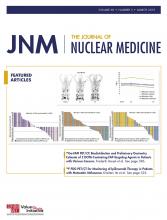TO THE EDITOR: Tian et al. developed a trifunctional ligand with an albumin-binding component (Evans blue), which features a longer-circulation half-life as compared with an unmodified DOTA conjugate. It has been shown in a preclinical model that the prolonged circulation improved the accumulation of this tracer in somatostatin receptor (SSTR)–positive tumors (1). In this study, bioimaging was performed by 86Y-DOTA-EB-TATE and PET as a substitute for 90Y-DOTA-EB-TATE for therapy. Dosimetric calculations revealed an increase of the tumor dose by a factor of 4 compared with the biodistribution without an albumin-binding functionality.
Similarly, Bandara et al. showed in a preclinical study that, in comparison to 177Lu-DOTATATE, 177Lu-DOTA-EB-TATE resulted in an increased tumor uptake over time, no unexpected accumulation, and efficient tumor control, despite similar activities (2).
Chen et al. applied 177Lu-DOTA-EB-TATE in humans and derived an increase in the tumor dose by a factor of 8 whereas kidney and bone marrow dose increased by a factor 3.2 and 18, respectively (3).
We investigated the labeling and the in vitro binding characteristics of 68Ga-, 64Cu-, 177Lu-, and 90Y-DOTA-EB-TATE in SSTR-positive HEK293-sstr2 cells (4) in comparison to unmodified DOTA-TATE conjugates. The cells were plated in 6-well plates 24 h before addition of the radiolabeled DOTA-EB-TATE and DOTA-TATE conjugates (200 kBq). Experiments were performed in 1 mL of standard cell culture medium at 37°C for 60 and 120 min. At each time point, the cells were washed with phosphate-buffered saline and lysed with 0.3 M NaOH. The uptake was determined in triplicate for each radionuclide and each time point and was expressed as a percentage of the total activity associated with 1 million cells. The labeling procedure was similar for all preparations, and the yields were more than 95%. We found for DOTA-EB-TATE that after 1 h the cellular uptake was 9.1% ± 0.69%, 2.0% ± 0.12%, 4.9% ± 0.26%, and 4.6% ± 0.21% and increased at 2 h to 15.6% ± 0.51%, 4.3% ± 0.18%, 9.0% ± 0.71%, and 8.1% ± 0.12%, respectively. In comparison, the bifunctional probes without the albumin-binding unit revealed a 1-h uptake of 23.7% ± 1.47%, 4.3% ± 0.18%, 8.7% ± 0.90%, and 7.2% ± 1.09%, which increased at 2 h to 27.3% ± 1.66%, 5.5% ± 0.36%, 12.6% ± 1.71%, and 10.2% ± 0.18%, respectively.
These data demonstrate that the modified radiotracer featured a lower initial uptake compared with the unmodified one, regardless which isotope was used. However, the incremental gain of the uptake within the second hour was comparable between both radiotracers. This demonstrates that the radioisotope strongly influences the uptake of the SSTR ligand. The highest diagnostic performance is expected from the radiopharmaceutical with the highest uptake, namely 68Ga-DOTATATE.
As a consequence of the different uptake, only different isotopes of the same element (such as 86Y/90Y or 64Cu/67Cu) can be used for assessment of biokinetic data, whereas theranostic “pairs” of isotopes (such as 111In/177Lu) are not appropriate. No solely diagnostic isotope of lutetium is known. Therefore, the use of a low amount of radioactivity for qualitative and quantitative (e.g., dosimetry) imaging is an elegant approach that allows a subsequent therapeutic application (3).
DISCLOSURE
No potential conflict of interest relevant to this article was reported.
Acknowledgments
We thank Dr. Xiaoyuan Chen, Bethesda, Maryland, for providing us DOTA-EB-TATE. The HEK293-sstr2 cells were a kind gift from Stephan Schulz, Jena, Germany.
Footnotes
Published online Nov. 15, 2018.
- © 2019 by the Society of Nuclear Medicine and Molecular Imaging.







